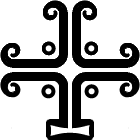Papa Stronsay Cross
When The Old Jewellery Box Shop, Basildon, UK sent us this photo, we were puzzled. What did it mean? Where was it from? Was it even a Christian symbol? Then they kindly explained all.
The image is from a cross carved in the 7th or 8th century on a stone slab discovered during excavations around the chapel of St. Nicholas. These ruins are on the islet of Papa Stronsay; one of the 70+ Orkney Islands off the north-east coast of Scotland.
Papa Stronsay (map) covers only 74 hectares (about 1/4 sq. mile) and above a sandy bay on its southern side is Golgotha Monastery. This was an old farm that was bought in 2000 by a community of a dozen or so monks known as 'The Sons of the Most Holy Redeemer'.
Adjacent to the farm were two small 11th or 12th century chapels: St. Bride and St. Nicholas. In the vicinity, a stone slab was unearthed carved with a cross and believed to pre-date the chapels by several hundred years. It bears features typical of Pictish art from 7th-9th century.
Above the cross is the inscription "d ne d i", which is taken to be the abbreviation of DOMINE DEI (O Lord God). The base of the cross represents the mound at Calvary, the place where Jesus was crucified. The lettering slopes and the top left quadrant is slightly larger than the other three. Whether this is an accurate representation of the actual carving is unknown, since the slab is now lost.
It looks very different from the common idea of a Celtic Cross, but in fact that's what it is. When we describe a Celtic Cross, we usually refer to the horizontal and vertical cross beams, and the large circle. We do not usually refer to the four small central circles, yet in several Celtic Crosses carved by Christian Picts, these four circles are significantly more prominent than the large circle.
As we can see in the Pictish cross at Dunblane Cathedral (photo), the large circle is barely visible, the four circles are pronounced, and two coils are shown at the end of each of the four cross members.
The Papa Stronsay Cross is featured on several items produced by the monks on the island.
And whilst considering the life of monks living in such isolation, we cannot resist the temptation to end this page with a little tongue-in-cheek story about another remote monastery: How Do I Become a Monk




